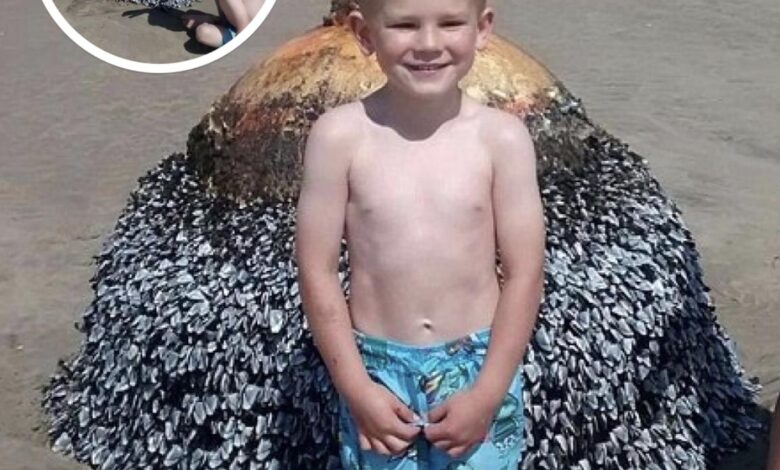
What began as an ordinary day of sunshine and laughter at the beach nearly turned into a disaster for one family in Carmarthenshire, Wales. Gareth and Kelly Gravell had taken their young children, six-year-old Erin and four-year-old Ellis, to Burry Port for a carefree outing in the summer of 2015. The beach was quiet, the tide was out, and the children were eager to explore.
Among the shells, seaweed, and bits of driftwood scattered along the sand, something unusual caught their eye—a large, round, seaweed-covered object. To the children, it looked like an old buoy, the kind of thing you might expect to find washed ashore after years at sea. To their parents, it seemed harmless enough, another relic of the coast. Laughing, Erin and Ellis climbed on top of it, treating it as part of their seaside adventure. They jumped, balanced, and played on the strange barnacle-encrusted object, while Gareth snapped photos of the innocent fun.
The family left that day with sandy shoes, happy memories, and a few photographs that seemed to capture nothing more than a charming day at the beach. What they didn’t realize at the time was that those photos also held the image of a potential catastrophe.
Just a few days later, everything changed. Local council rangers abruptly closed off the beach after identifying the “buoy” as something far more sinister: an unexploded World War II mine. The rusted, seaweed-cloaked object that Erin and Ellis had been climbing on was not a nautical relic at all—it was a bomb, dormant but still deadly after more than seventy years.
The discovery prompted swift action. Bomb disposal experts were called in to assess the situation, and authorities decided the only safe option was a controlled detonation. Onlookers watched from a safe distance as the mine was towed to the far side of the harbor. Then, in a thunderous explosion, the decades-old weapon was destroyed, sending water and sand shooting into the air. The dramatic blast was captured on video, underscoring just how dangerous the situation had been.
When Gareth learned the truth, he was stunned. He shared his shock on social media, posting the family photos alongside the unbelievable revelation. His tweet, laced with equal parts horror and humor, read: “So the buoy my kids were jumping on all weekend turns out to be a WWII bomb. Oops.”
The post quickly went viral, with thousands of people reacting in disbelief and relief that no one had been harmed. Some commenters expressed amusement at the family’s near miss, while others pointed out how close they had come to tragedy.
Speaking later, Gareth admitted he could hardly believe it himself. “You just don’t think something like that could happen at a beach you visit all the time,” he told reporters. “It looked old and rusted, but we assumed it was just part of the usual debris you see along the coast.”
Experts explained that the mine had likely been buried under sand for decades, hidden from sight until recent tides and weather patterns exposed it again. For Kelly Gravell, the experience was chilling in hindsight. She recalled how the children had been fascinated by the barnacles clinging to the object and how, at the time, no one thought twice about letting them play on it. “We even joked about it looking like a bomb,” she admitted. “We were so close to disaster—it’s shocking to think about now.”
Kelly emphasized that the family wasn’t deterred from returning to the beach in the future, but they would certainly exercise more caution. “I wouldn’t be worried about going back, but we’ll definitely think twice before touching or climbing on something we don’t recognize. We actually went back to watch them blow it up—it was surreal.”
Local officials praised the public for their cooperation during the evacuation and apologized for the temporary closure. Councillor Meryl Gravell, speaking on behalf of Carmarthenshire Council, reassured residents that the matter had been handled with the utmost care and that safety would always be prioritized over convenience.
The incident, though it ended without harm, serves as a sobering reminder of how wartime relics can still pose real dangers decades later. Across Europe, unexploded bombs and mines from World War II are occasionally unearthed, whether by construction work, shifting tides, or sheer chance. While most remain hidden, those that resurface can create dangerous situations in the most unexpected places—even on family beaches.
For the Gravell family, the day has become an unforgettable story to tell. The photographs, once just snapshots of a cheerful afternoon, now serve as chilling proof of how close they came to tragedy. Their children’s laughter and games had unfolded atop a deadly remnant of history, and only luck spared them from disaster.
Reflecting on the experience, Gareth and Kelly have both urged others to stay alert when exploring coastal areas. “If you come across something unusual, don’t assume it’s harmless,” Gareth said. “It’s always better to report it and be safe.”
What could have been a heartbreaking tragedy instead became a tale of relief, caution, and gratitude. For Erin and Ellis, who were too young to understand the danger at the time, it remains a story their parents will likely repeat for years—a reminder of the day they played on history and walked away unscathed.